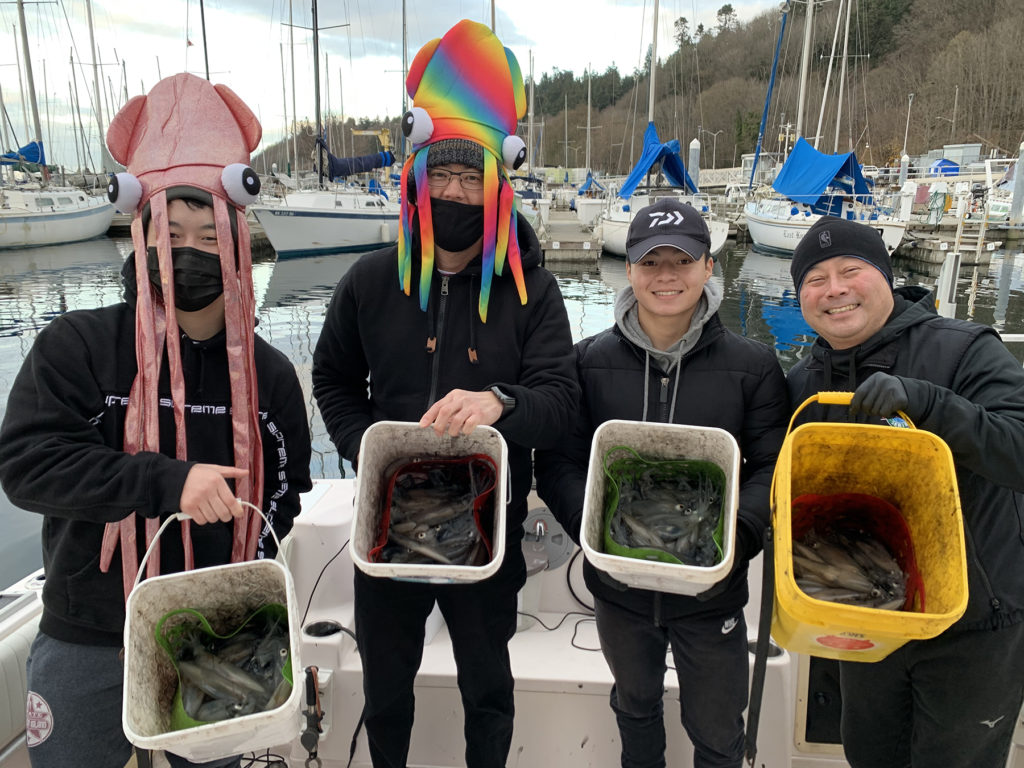
How can it be December already? While holiday shopping and gatherings are high on the priority list for some, many others are happily doing the “jig” instead. This lively dance is happening right now on boats and off piers throughout Puget Sound as anglers try their luck at jigging up squid. The thought of bringing home this highly sought-after delicacy—think deep-fried calamari with a gob of creamy tartar or aioli sauce—will have you jigging for more.
“The last several years were pretty good for squid, and this season has gotten off to a somewhat rocky start, although we’ve started to see them in larger schools,” said Paul Kim, owner of Seattle Squid charter service in Seattle. It has been a longstanding tradition to catch them off piers, but the new rage is jigging on a boat, adds Kim. He points out this isn’t a highly technical fishery and can provide a fun time for anglers of all skill levels.
I had a chance to jump aboard Kim’s 21-foot Grady White boat twice last month, and chasing squid in total darkness is unlike anything else I’ve ever experienced as a lifelong Pacific Northwest angler.
Large powerful 1,100-watt LED commercial lights, powered by a generator, were hung off the boat’s bow and port and starboard just above the water’s surface. These were combined with a pair of 108,000 lumen UV spectrum lights dropped into the water off the boat’s stern, plus the underwater transom is mounted with fixed 20,000 lumen LED lighting. Thus, the water within a 25-foot radius was lit up like North Seattle’s Candy Cane Lane during the holidays.
The powerful lights are used to attract squid to the boat, and an anchor was lowered off the bow to keep us right on top of the squid. Squid are found just below the water’s surface down to the bottom at depths of 25 to 130 feet (deeper areas require a heavier lead weight), so our fishing gear consisted of a sensitive 9-foot trout rod and spinning reel with 10-pound braided or 12-pound Izorline Hi Vis monofilament line. This enables you to feel the subtle tap or vibration of an attacking squid. Each rod was equipped with either one or two or three weighted luminous glow-in-the-dark plastic pink, red, orange, bright blue, or chartreuse jigs. The jigs don’t have hooks and instead have slanting sharp prongs that squid wrap their tentacles onto. Keeping a steady upward pressure (don’t reel fast), and being sure to give no slack on the line are key, otherwise those slippery squid will simply let go.
The best period is night time, although they’ll often stay on the bite into the early morning. When plentiful, you can even catch them on a mid-day tide change.
Unlike the tentacled sea monster in Jules Verne’s classic science-fiction novel 20,000 Leagues under the Sea, the Puget Sound squid known as Pacific squid or market squid, measure a mere 4 to 12 inches with a short life cycle of about 18 months. Puget Sound is one of top marine areas where squid migrate each winter to lay eggs along the gentle sloping sandy bottom near kelp and rocky areas with good natural or artificial light. They tend to hide in the dark, shadowy edges of lighted water, and then dart out into the light and onto their unsuspecting prey. This is why places in Elliott Bay, where light bounces off the waterfront, around the Big Wheel, Piers 69 and 70, Colman Ferry Landing, and Seattle Aquarium, or the Seacrest Pier, and Todd’s Shipyard in West Seattle, are traditionally the “go to” locations.
The primetime for squid jigging usually occurs from September through February. Not much is known about their exact migration timing. Some years, they’ll appear as early as end of summer or other times, they will be late to the show, which will probably be the case this winter.
Learning how to fish from a boat isn’t too complicated, but if you’re unsure I’d recommend going with a fishing guide like Kim to learn the ropes. To book a trip ($130 per person) visit: seattlesquid.com. The WDFW website also has a wealth of information on catching squid at wdfw.wa.gov/fishing/basics/squid.


